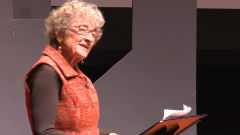Lucy Lippard
For over 50 years, Lucy Lippard, art critic, writer, curator, and activist, has played a critical role in shaping—and simultaneously deconstructing—what we define as “art.” After becoming a critic for Artforum in 1964, Lippard eventually rejected conventional art criticism on the basis of its need for “so-called objectivity” and lack of contact with artists and their practice. She went on to become a key figure and commentator on Minimal and Conceptual art. Her book Six Years: The Dematerialization of the Art Object (1973) both catalogued and described the development of Conceptual art practices in the late 1960s and early ‘70s. It is now widely considered an essential reference work for the period and is a staple of contemporary art syllabi in classrooms across the globe. In addition to Six Years and an impressive body of essays, Lippard has published more than 20 books on feminism, art, politics, and place since 1966. Always seeking more active ways to bring pressing issues to the forefront of national dialogue, Lippard has helped start such artist groups as the Heresies Collective (a group of feminist artists that published the journal Heresies: A Feminist Publication on Art and Politics from 1977 to 1992), Political Art Documentation/Distribution, and Artists Call Against U.S. Intervention in Central America. She has also curated more than 50 exhibitions and has been a visiting professor at the School of Visual Arts, New York; Williams College, Williamstown, Massachusetts; The University of Queensland, Australia; and the University of Colorado Boulder.
Why we love Lucy Lippard:
• Lucy was key in bringing the voices of women to art criticism
• Her writings, including the seminal Six Years: The Dematerialization of the Art Object, are required reading in classrooms around the world and were the subject of a groundbreaking exhibition on Conceptualism at the Brooklyn Museum in 2012
• Lucy’s extensive list of accomplishments and awards includes a Guggenheim Fellowship, the Frank Jewett Mather Award for Criticism from the College Art Association, and two National Endowment for the Arts grants

